Forbes published research showing you, and your business, have just seven seconds to make a first impression - that’s about the time it takes you to shake hands. Why am I telling you this?
Because first impressions are critical, and creating effective marketing demo presentations can help you elevate the conversation and have invaluable business solution discussions.
In this article, I’ll share five common mistakes made when it comes to product demos and how to fix them, sharing lessons learned from my own experience along the way.
About RingCentral
We're a collaborative communications company, we allow employees internally to collaborate with each other, whether it's messaging, video meetings, whiteboard, collaboration, sharing documents, sharing videos, and also just the standard calling.

We also allow employees within a company to collaborate with their customers through our contact center solutions. The contact center side is what I'm focused on. I want to give you a sense of the challenges we face when looking at demos specifically, but overall within product marketing and marketing of contact center.
Contact center is a very mature market, there isn't a whole lot of innovation going on in terms of features. Pretty much everyone who's out there today has this widget and that widget in some form or another. Differentiation is extremely difficult.
The biggest innovations in the last five years are the move from premise to cloud - we joined everybody else. And the move from calling to digital communications as the primary method of communication.
Product adoption curve
The reason for that is, if you look at the standard product adoption curve, end of life is somewhere around where you can see my marker.
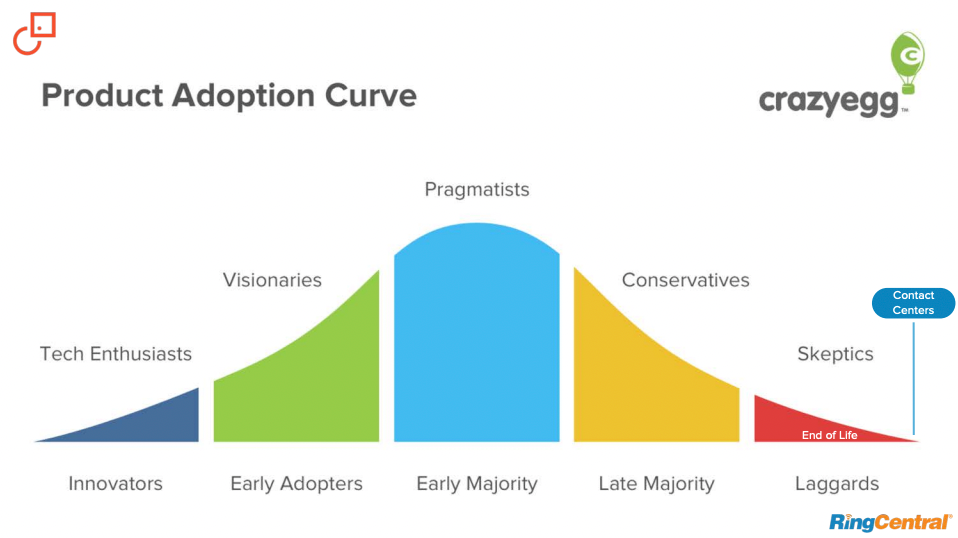
That's when contact center adopts technology. Very risk-averse. If it's not broken, don't fix it and so selling into the space is very hard and the two big things, moving to cloud and digital, are the ones that are driving a lot of the new sales.
That's why we are successful because that's what we sell. Positioning products and demoing products in that space is very difficult so you have to be very clear and concise. You have to show the value of your solution because you might have widgets A and B but your competitor has widgets A and B too, why is your solution better? Why do we want to use your solution versus your competitor’s solution?
It's extremely important in this realm. I'm not saying it's a unique challenge to us, I'm sure a lot of you have the same challenges but in a mature market like this, it becomes specifically challenging.
Why are demos important?
Who cares? We can do demos all day long, we can show how wonderful our product is, we can demonstrate it to C-suite folks or IT, we just show our product and that should be all we need to show because it's perfect, it's beautiful, it works, right?
Turns out, that's not the case. When I took on this responsibility, I immediately saw the opportunity to start bringing in the demos that were technical demos, given by our sales engineers, and turning them into marketing scripted demos, part of marketing campaigns that could be measured, used to tell a story, and specifically to solve a business problem.
That's really what we've done over the past eight to nine months - really raised the level of the conversation and elevated the conversation. We're no longer having a technical discussion. We're having a business solution discussion. How are we going to help you solve your problem? The technical discussion comes later, as you'll see.
Here's why:
First impressions count
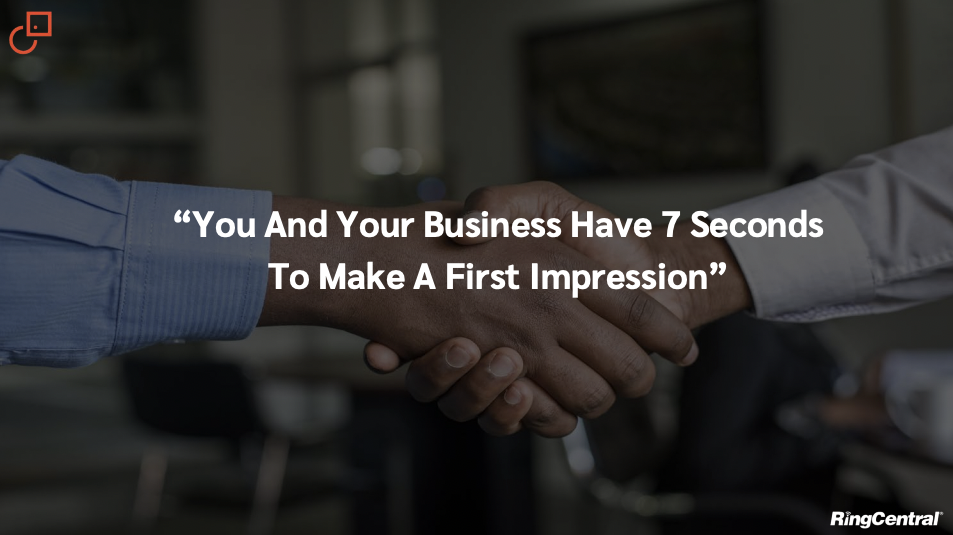
Not too long ago, Forbes launched a study where they pulled a lot of companies and said: How long do you think it takes you to get a first good impression of a company? Barely the time it takes to shake hands, that's how quickly you can lose their attention.
While you're reading this article today you're likely also doing work. You're on your phones, you're on your computers. That's the reality of our lives, we're busy, even though you're reading this to learn, you're getting buzzed.
So you get another vendor showing up to sell their technology, they think their technology is better than everyone else's, why would I want to listen to you? It's making that first impression.
Now, it takes a lot longer than seven seconds to do a demo but you're talking about maybe a 45-minute to an hour meeting. You want to keep them after those seven seconds, engaged. That's key here.
Common mistakes & how to fix them
Thinking it's all about technology
When I joined managing demos, the sales engineers were super excited. "Oh, that's great. Hey, can you write me a script that does this? Hey, can you fix this for me?"
No, I won't fix your computer. But what I will do is help you prepare and deliver better demos. The first thing is not to focus on technology.
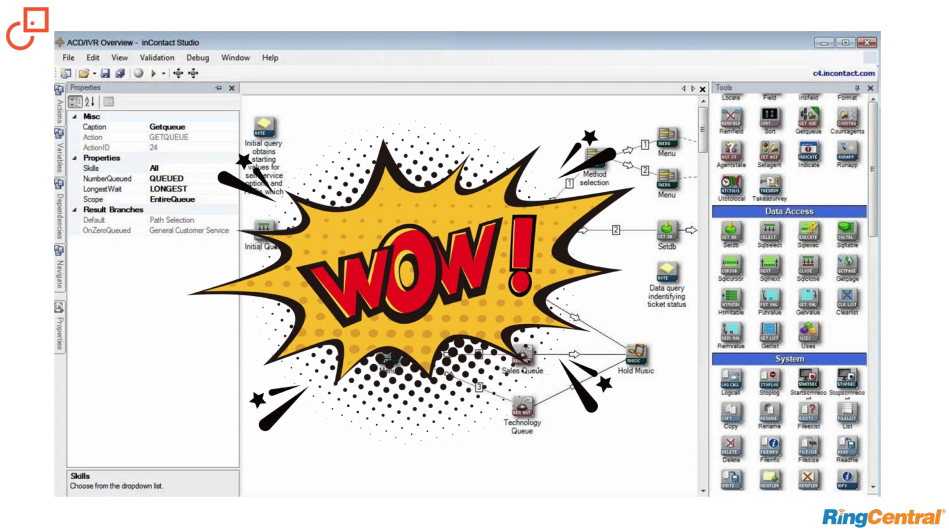
Would you buy this today? Just looking at it?
The reality is this actually works really well. It's one of the things that differentiates us as a vendor. It's a very powerful solution. But you wouldn't tell by looking at it.
Demos immediately dive into the product, its features, and how awesome it is.
This is what we were leading with, we were saying "look at this beautiful tool, it's got arrows, graphics, this cryptic screen over here, look at all the icons, you have, 1 million capabilities". Not impressive.
Not to say this isn't important but this is not the stage at which you present this. This is a later discussion. What you're doing with your first set of demos is to try and get to another discussion.
As you're drilling down, you start at the C-level, you start at the decision-making level, once they're committed to liking your solution "I think it's great. I think it'll solve our problem. Let me put you in touch with our technical team who will have to implement this". That's when you have this discussion.
But we were leading with this, and it's a big mistake. Robert Falcone wrote a really interesting book called Just F*cking Demo. He has a lot of experience doing this kind of stuff, I read his book, and I followed his literature. I learned a lot from him and from others who have done this and have been through this process. It's nicely summarized here...
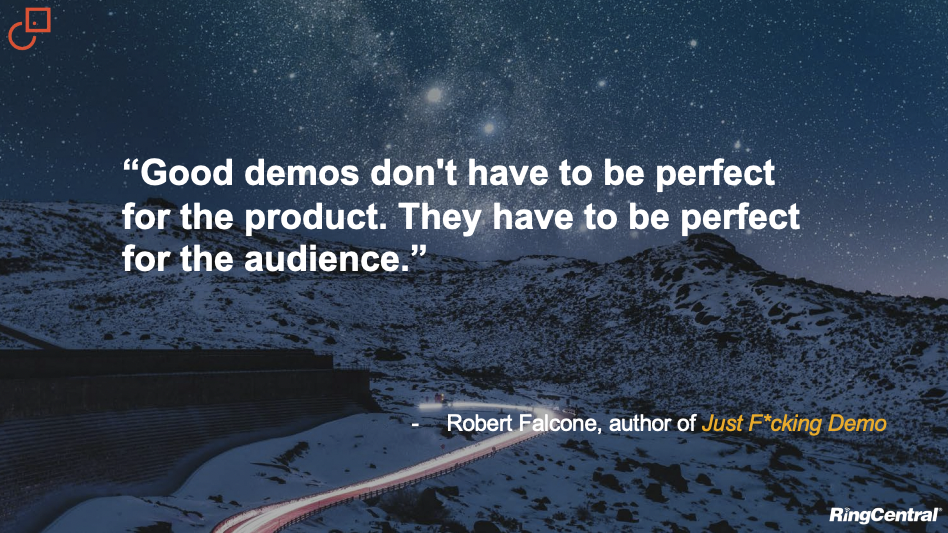
Your product demos suck because you're focused on your product.
What’s wrong with this approach?
It dilutes the business value - By doing that you're diluting the business value, immediately. By showing that screen before you're not showing me how I'm solving my problem. It completely dilutes the business value.
It exposes feature gaps - It exposes feature gaps, remember what I said earlier about how our industry is very sensitive to that because features are not really a thing because they've got it too so why is yours different?
When you start drawing attention to feature gaps at the first couple of meetings, you've lost them.
Technical issues become the focus - Then technical issues become the focus, demos always go wrong, that's going to happen.
When you get further down in the process, and you're showing the IT folks stuff, and some things go wrong - at that point, they understand there's going to be issues, they know about that, they deal with issues all the time. But never in the first couple of meetings, you want to make sure that's not a distraction.
Your product is worthless unless it solves a specific business problem.
From a business value perspective, really, your product or the products we sell are completely worthless unless it solves a specific set of business problems.
The kind of questions companies are looking for when you actually show them or demonstrate the product are:
- How does this make our job easier?
- How does this allow us to better serve our customers? We're B2B but it can also be looking from a B2C perspective.
- How does it cut my costs? Because I'm always looking to drive cost out of the solution.
- How does it allow us to meet or exceed our KPIs and SLAs? We, as an organization, are accountable to the board, we're accountable to other organizations, we're measured based on that, sometimes we're even paid based on that.
- How does it allow us to scale and grow our business? We're growing fast, we need a technology that helps us keep pace with our growth or help us grow.
- How does your solution do that?
The key is understanding the problems first. Yes I have a product demo to show you, but first tell me a little more about your company, what do you do? What issues are you experiencing? Okay, now let me show you what my solution does to help solve that problem. That's really key.
Technical problems
Microsoft was one month away from launching Windows ‘98 back when operating systems were a thing. Bill Gates was up on stage with someone in marketing and they were getting ready to show plug and play. Back then it was a big thing because the operating system couldn't do it so that was one of the big advantages of Windows 95/98.
They were going to demo adding a scanner and showing how the system detected the scanner. Remember, this is April and they were supposed to ship Windows ‘98 in May.
A great recovery from Bill Gates obviously but Microsoft learned a lot from this. Their demos adjusted and changed as a result of this because this was on CNN back in '98. It was broadcast everywhere and somebody captured it on videotape because that's what you did back then and now it's posted on YouTube so everyone can see it.
Bill can laugh at it now but back then it was no laughing matter. Drawing attention to this kind of stuff - that's what people are going to focus on and that's a problem because you really can't get to the next level when they can't even see beyond 'Wow, your demo completely crapped out why would I use it?'
Generic demos
One size does not fit all - another thing we learned.
When I joined RingCentral, we were doing one kind of demo, it was a technology hub or something and we were showing this demo to every customer whether they were in health care or finance.
It was quickly apparent that although they found the demo interesting, it wasn't really resonating with them because 'I'm not a Wi-Fi provider, I'm a bank. I'm a healthcare provider. I'm a healthcare payer. I'm an insurance company’.
Again, another great point from Robert Falcone, good demos don't have to be perfect for the product they have to be perfect for the audience. That's one of the changes we made, we looked at:
- What verticals do we want to go after?
- What verticals do we want to focus on? And,
- What are their problems?
They're different.
Different industries - different problems
If you're in the healthcare industry, you're very worried about things like medical records, scheduling, post-op procedures, consultations, surgery, and follow-up.
Of course, you want to make sure you're compliant, following HIPAA compliance, they're under very strict regulatory guidelines around what they can and cannot do and what information they can provide. So having a secure solution to be able to support that.
Finance is completely different. If you're a bank, you're worried about online banking, ATM services, branch locations, and services - just a few of the things. Financial products and asset management are completely different again.
One set of problems here, another set of problems there.
The finance industry is also bogged down with compliance and being sure to comply, the regulations around it are different. It's PCI in the case of the finance industry and in the case of banking. How do I keep social security and credit card information secure so you're not storing it on your system?
In retail, how do I get people into my stores? How do I promote sales to get more people to come? How many people in my brick-and-mortar store versus my online store? How do I manage inventory? How do I do things like geofencing where a customer is in the store and based on where they are, we can say "hey, there's this promotion on aisle four".
Tailor your demos
Very different problems for very different industries and you have to cater and tailor to those industries when you are showing a demo.
So when you show a demo, you're not showing 'we're the Wi-Fi vendor' you're saying, 'I'm a healthcare provider and I'm going to walk you through a scenario as a healthcare provider, each step of the process is going to answer each one of these questions for you. By the end of my demo, and it won't be more than 10 minutes, you'll have a pretty good idea of how we can help you here'.
Grand Travel - For our first vertical, which was travel because we have some success in the travel industry, we created our own website - a fake website - Grand Travel. We created a bunch of assets in the social world, including an Instagram page.
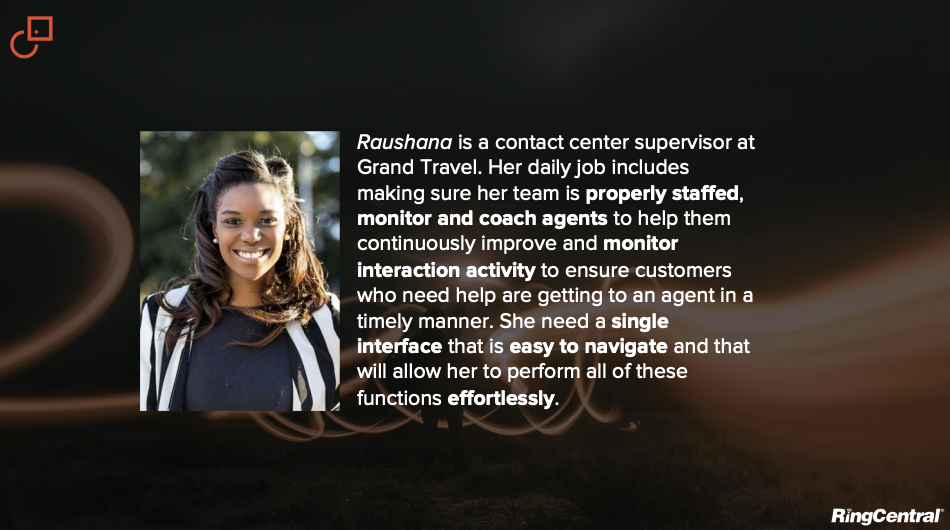
It's actually interesting because I have actual customers posting there asking about travel packages and I have to explain this is a demo environment, sorry.
It's realistic enough that when customers look at this or we take this to travel companies, they go, "Oh, this is pretty cool so I can have a social presence, I can be on WhatsApp, Facebook, Facebook Messenger, and even a mobile app to go with it".
We've totally customized the experience to travel and made it relevant to travel. What's travel worried about? Things like booking trips, going on vacations, what happens when my flights been canceled or delayed? How do I get ahold of you? Can I message you? Can I call you?
Putting it all together within the context of travel. It's about showing how do my people, my company, my processes, and my technology do all the heavy lifting for your company? Let me show you how that is in a demo.
That's really what I'm talking about here.
Lack of consistency
Demos with inconsistent messaging and delivery. Probably one of the most maddening things I discovered when I first joined RingCentral is trying to bring all that together.
We were really all over the place. It was like, 'Welcome to Demo Island' - I know it's pretty tacky, right?
Because customers do get confused. They do read our literature, go to our website, and watch our videos. Then we come and do a demo that's completely different. "None of this was in the literature you provided, what are you showing me here? You said you had this but now you're showing me that".
It has to be consistent with your marketing campaigns and your marketing literature, whether it's a go-to-market campaign or an awareness campaign, whatever you're doing, these demos have to be consistent. They have to have the same messaging, and everything has to be consistent across the board.
Marketing programs > demos
Demos are really fed from your marketing programs which is a completely different approach from when I started when demos were sitting all on their own and we just did them. Now when we do demos, we look at what marketing program are we work on?
What are the things we want to accomplish as a marketing team, that's not just product marketing, but globally marketing-wise, branding, etc. How do I make and create demos that filter all that content; the messaging, the content, and the narrative we're trying to share with our customers and our prospects?
The evolution of demos
That's why demos have slowly been moving from sales engineering to technical marketing, to product marketing. I don't know how you're laid out but basically, I do the same role. Mine is a technical slash product marketing role.
But you don't have to be technical to run demos, you don't have to be technical to build and develop and design demos, you have to understand problems. That's all you need to do - the technology stuff, someone else can handle that.
It starts with your marketing objectives, what are we doing, market awareness, demand strategy, products and partners, case studies, campaigns, analysts, all our marketing literature that's online, nurture and drip campaigns, mass advertising campaigns, our sales enablement, our playbook, the complete playbook and how we're going to talk about collaborative contact center, and then bring demos into that.
So demos become a key part of that.
Analytics
It's great that you're doing demos and scripted demos and they're out there but not if you don't have a way to track it, and understand:
- How is this working?
- Are people registering with us and getting those demos?
- What is the result of those demos?
From a demo perspective, really, the result is, let's get to the next meeting, let's get to that deeper level discussion, let's start talking about pricing. So getting metrics and analytics, as you do with everything else in a marketing campaign, is extremely important.
That has to be part of your demo strategy.
Unscripted and unrepeatable - Tell a story. I can't say it enough, everyone can't say this enough. Tell a story, you want to tell a story, you want to lead them through a narrative.
Scripting - You want that story to be consistent for prospects, customers, analysts, and the press.
What I tell customers should be the same thing I tell analysts and the same thing I tell the press, because when analysts report on it, or the press reports on it, I want the customer who's seen the demo to say 'Oh, yeah I saw this', not 'wait a minute that's not what I saw, I saw something different'.
Personas - Creating personas, these are actual personas we use in the contact center for this Grand Travel demo environment that we've set up.
Different stakeholders in the business, these are all contact center agents, supervisors, business analysts, and the IT department. All these people are involved in implementing a contact centre solution, all of them have a stake or will have a decision ultimately, on whether or not your solution will be the solution they adopt.
Be very specific about your personas:
- Who are they?
- What's their daily job?
- What problems do they have?
Be very clear about the issues they're facing and they should line up with the industry you're targeting here as part of the demo. Now you set the stage for them to say, "Okay, yeah, this is exactly the problem we're having".
Manage resources - In a lot of cases, certainly in our case, we have a lot of integrations that we support, and a lot of licensing that we have to deal with. It can get really expensive.
Sales engineers, ideally, would want everyone to have their own account but you can't really do that, it's cost-prohibitive. What you need to do is manage those resources.
Creating a booking system, which we've done here, allows them to reserve personas, those personas we just saw, and allows them to use them for a given period of time and then check them back in.
That also allows us to track who's using it and how they're using it - metrics again. You get a confirmation with all the persona details which makes it really easy to log in and manage your demo.
Then going through a narrative, a story, my customer starts an interaction with me, I'm an agent, here's how I respond, agent interface, very simple to use, here are the tools they have at their disposal.
You can get some surveys your analyst is going to be interested in looking at. Your supervisor has complete visibility and can actually really easily coach the agent while they're doing the work.
Showing through the narrative, how I'm solving each and every one of these problems for each of these personas.
Terminology
This is a pet peeve. On the left is a tool, in the middle is also a tool, on the right that's an application.
SEs say "we have this beautiful tool that you can use" - it's an application, it's a solution.
Tools are a thing you can use to build stuff, there can be software tools as well. In this case, it's an application. Making that consistent across the board is important.
At the conclusion of that narrative, you want to:
- Reiterate the business problem,
- Show how you solved the problems for each of the personas, and include
- A call to action, next steps.
That's really where you want to get to - next steps. Let's have another demo, we'll show you more details. Let's talk about pricing. Let's talk about how this fits into your business.
Set and forget
Last but not least, demo enablement. Demos and management and implementation of demos is an ongoing process, things change, things break, development comes up with a new system or a new development, a new application, it goes live and suddenly 'wait, why isn't this working anymore?'
You have to be on top of things continuously as you do updates, also new capabilities, new things that we want to highlight, potentially maybe a new marketing campaign, things you want to highlight.
Being able to actively manage those demos. Creating an environment where your demo stakeholders, your sales engineers, increasingly salespeople, analysts, and partners can go in and be able to book a demo, manage a demo, get all the scripts they need and get the updated messaging as things change.
Putting resources available to them, providing video tutorials and documentation. Giving them an opportunity to provide you with feedback is really key. This is what worked, this is what did not work so that we can continuously improve the demo process.
Resources and accessibility
Step by step demos - We've been doing live demos pretty well now, our SEs have been doing this for a while, our field SEs who are less versed in this product specifically, general SEs, and our salespeople now have come to us and said, 'Hey, I really like this demo stuff you guys are working on can I do it?'.
So we created a step-by-step demo for them, basically took what you would script or run through in a live environment and now do a step-by-step with all of the scripts available to them.
This is just a Google Doc, that was the easiest way we thought of implementing this, the easiest way they could understand it, or use it, or consume it.
We're not going to fight that we're just going to go with that so now they can go anytime to any customer, and run through the script.
We even did this with the analysts. It doesn't have to be a live demo, is what I'm getting at. It broadens your audience and broadens your stakeholders - the people that can use it.
Click-through demo - We're also introducing a click-through demo. This is on our website, it's gated so you have to sign up but you can basically click through the product and we explain at every stage what the product does, what the value is.
You can even explore it, you can stop at any time and explore it.
We track all this. This is a demo, but it's a self-serve demo. I go in, I sign up, and I could walk through the product. At different stages I can see what my customer is doing here, I know what they're up to.
Then when we do the follow-up, I can say, 'hey, it looks like you're interested in this, this, and this. Let's talk more about that.'
On-demand webinars - On-demand webinars, which we also track in terms of usage, what they're watching, how long they've been watching for, and so on. Yet another way to demo the product.
Summary
To summarise, you should focus on solving business problems, cater to different personas and industries, tell a narrative - not focus on a technology.
It should be a marketing program asset, should allow for many different delivery models, and should be supported through a demo enablement program.
Good demos should:
- Focus on solving business problems,
- Cater to different personas and industries,
- Tell a narrative, not focus on the technology,
- Be a marketing program asset,
- Allow for many different delivery methods,
- Be supported through a demo enablement program.
Thank you.
A little about the author
I've been in product management for over 20 years and moved to product marketing when I moved to RingCentral. I don't regret it one bit. In fact, I'm trying to figure out why I didn't do this earlier, I love product marketing.
That said, probably just like a lot of you reading, I have come from another discipline - product management. When I first joined RingCentral, the number one task I had was, "Hey, can you make these demos better, manage them".
I asked, "what do you mean by manage them?" The response: "Figure it out, that's what you have to do". In this article, I'll share my experience and what I've learned, I'm by no means an expert, I'm still learning. But we did learn a lot in 10 months, and we made a lot of changes in 10 months.
What I'm going to share with you is our experience, and what has happened over those 10 months, the lessons learned, and the mistakes so you don't have to repeat them you're trying to do this.
[At the time of delivering this presentation, Alain was Senior Product Marketing Manager at RingCentral but he has since moved into the role of Director, Product Marketing, Customer Engagement and Collaboration at Talkdesk.]


















 Follow us on LinkedIn
Follow us on LinkedIn





.svg)
Start the conversation
Become a member of Product Marketing Alliance to start commenting.
Sign up now